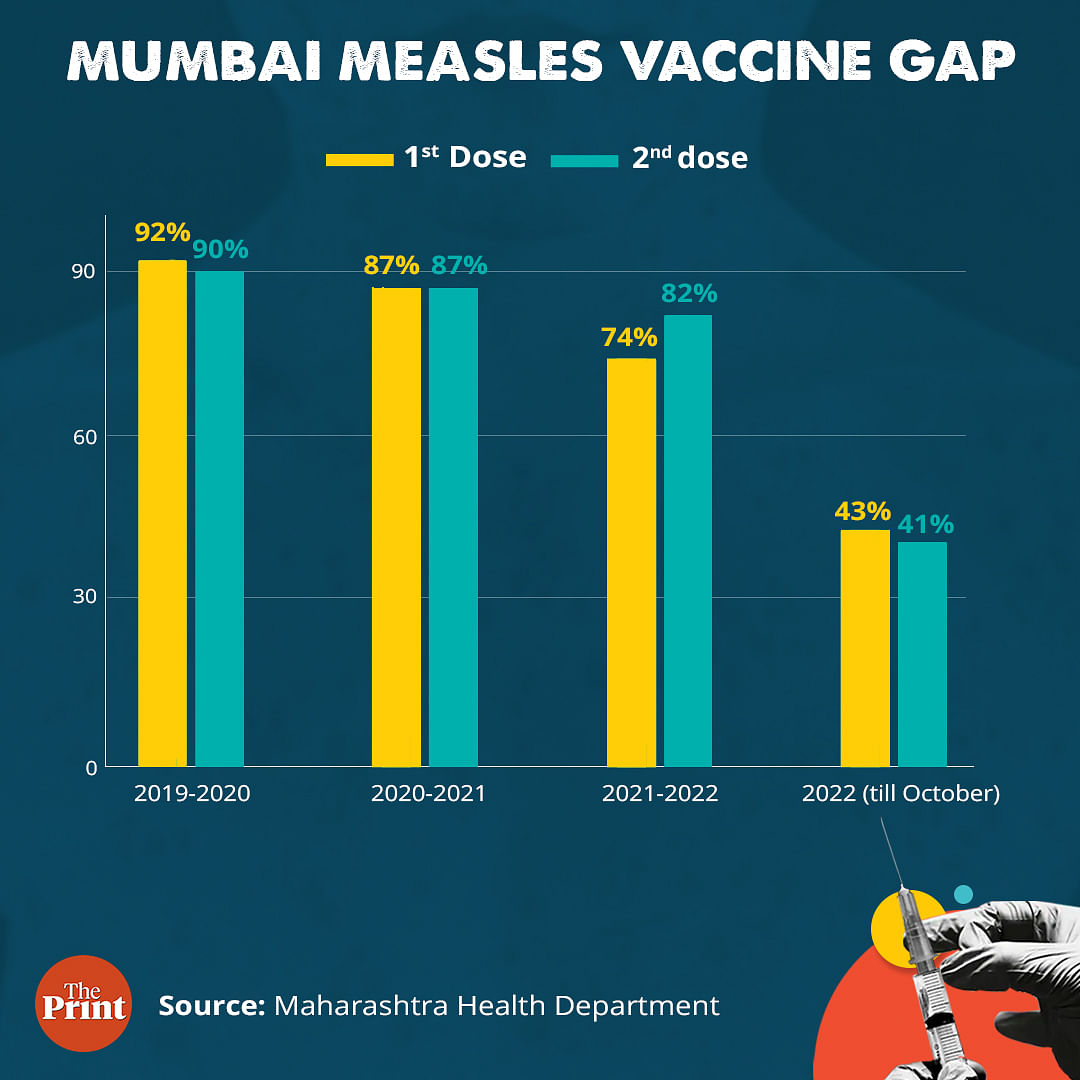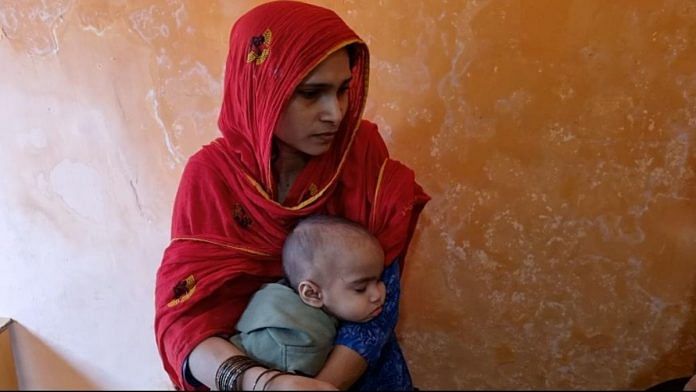Mumbai: When 14-month-old Fazal Khan developed a fever sometime around mid-October, his family, living in Rafi Nagar in Mumbai’s Govandi area, initially took him to the local doctor for treatment. The fever, however, would not subside. Nor did the rashes on his body go. And on the morning of 27 October, he died. The day before he had been admitted to the Brihanmumbai Municipal Corporation (BMC)-run Rajawadi Hospital, after he started having trouble breathing.
He was the second of three cousins to die within just days. None of the children were aged over five, and all three succumbed to the same illness — measles. According to the BMC, they were the first casualties of an outbreak which has now spread across Mumbai and many other parts of Maharashtra.
While his parents have blamed the hospital for negligence, Dr. Mangala Gomare, executive health officer, BMC, told ThePrint, “Proper care was taken, but they came to the hospital very, very late and despite all efforts, they could not save him.”
According to data shared by the BMC, as of Friday, Mumbai had reported 252 confirmed cases of measles this year and 8 deaths.
Fazal had not received the MMR (measles, mumps and rubella) vaccine, the first dose of which is administered at the age of nine months.
“My health was not well, so I had not vaccinated him when he was nine months old. My sister, who was taking care of him, was not aware of the vaccination schedules. He was just given one injection when he was six months old and had had a cold and a cough,” Shahin Khan, Fazal’s mother, told ThePrint.
Following the outbreak in October, the BMC started an immunisation drive earlier this month, as missed or low vaccination owing to the Covid-19 pandemic over the past two years was believed to be the main reason for the sudden outbreak, said BMC officials.
“For the past two years, many children have missed their immunisation. Many parents thought it was not the time to get vaccinated, or they were afraid. There was also hesitancy in some pockets and this has added to the unimmunised population,” said Dr. Gomare.
Not just in Mumbai, other parts of Maharashtra are seeing a growth in the number of measles patients. According to data shared by the state health department, cases of measles have been reported from Malegaon, Bhiwandi, Thane and Vasai-Virar.
An airborne infection like Covid, measles has an estimated R0 of 12-18 and more commonly affects children below five years of age. The R0 is the index of infectiousness, measured as the average number of people that a person infected with the disease is likely to spread it to.
A study published in 2019 found the mean case fatality ratio for measles to have declined substantially, to an estimated 2.2 per cent, in 1990-2015, owing to increased immunisation cover.
In the past few weeks, localised measles outbreaks have been reported from many parts of Maharashtra, Jharkhand, Kerala and Gujarat. When an area sees more than five suspected patients within four weeks, with two of them confirmed patients, it qualifies as an outbreak.
According to data shared by the state health department, this year Maharashtra has reported 50 measles outbreak areas, as against one in 2021, two in 2020, and three in 2019.
According to health experts, despite lower immunisation cover, the spread of measles in the past two years was kept under check by the social distancing necessitated by the pandemic.
Also read: After Covid, mRNA vaccine for cancer? US researchers report initial success against melanoma
Checking the outbreak
According to a survey conducted by the BMC in November, around 20,000 children in Mumbai (in the 0 to five years age group) were found to be either partially vaccinated against measles or not vaccinated at all.
At the time of the present outbreak in October, only about 43 per cent children in Mumbai had received the first vaccine dose, while 41 per cent had been fully vaccinated, stated data presented by the state health department to the government and accessed by ThePrint. In absolute numbers, this would mean that of a total targeted population of 1,71,890 children, only 73,120 had received the first dose, while only 70,102 out of the targeted 1,69,728 had been administered both doses.

Under the Universal Immunisation Programme, a child gets the first dose of the measles vaccine between nine to 12 months and a second dose is administered at the age of 16-24 months.
According to state data, in 2019-20, 92 per cent of targeted kids had been administered the first dose of the vaccine, while 90 per cent received the second dose.
The number dropped with the onset of the pandemic, however, with 87 per cent receiving both the first and the second dose in 2020-21. In 2021-22, it went down further, with 74 per cent being given the first dose and 82 per cent of the targeted group being administered both doses.
To check the present outbreak, the BMC has now adopted a three-pronged approach. The first step is a door-to-door campaign to identify suspected cases, said Dr Gomare. All those with fever and rash are then being given two doses of vitamin-A, within a gap of 24 hours.
Those perceived to be requiring medical attention are referred to nearby paediatricians and dispensaries, while those with secondary symptoms, such as loose motions, reddening of eyes, rashes, are being advised hospitalisation.
Poverty, low vaccination
Meanwhile, Rafi Nagar, a slum pocket in northeast Mumbai has been reeling under the impact of the outbreak over the past few weeks.
A part of the BMC’s M-East ward, Rafi Nagar is home to a large migrant population, of mostly daily wage earners. The low awareness level about vaccinations is one reason for the low immunisation numbers here. The other is vaccine hesitancy.
Parents ThePrint spoke to here expressed fears of their children getting fever or other complications if vaccinated.
“I am afraid the child will get a fever. My mother-in-law too did not allow any of my children to get vaccinated. Who will take care of the complications,” asked Shabina Shaikh, a mother of three, aged one, two and four years.
Shabina’s youngest, had been suffering from cold, fever, and loose motions for three days when ThePrint caught up with her Thursday.
“This is a classic case of suspected measles,” said Rajesh Prajapati, a doctor who runs a clinic at Sanjay Nagar in Govandi. “If such a patient is brought in late to the clinic then the treatment gets delayed. The golden hour (time during which treatment has the highest likelihood of succeeding) passes and complications may increase,” said Dr. Prajapati.
Health officials and experts point to low immunisation along with malnourishment as one of the major reasons for the outbreak.
Arman Ansari, also visiting the same clinic with his year-old daughter, admitted the child had not been vaccinated for measles. She was suffering from fever and there were rashes on her body. “I had not known about it (the vaccine). Had I known, I would have given it. Nobody told me about it,” he lamented.
According to Shaikh Faiyaz Alam, president of the Govandi New Sangam Welfare Society NGO, lack of awareness was a major issue among the population here.
“Sometimes when anganwadi or BMC officials come into the shanties, slum dwellers don’t respond positively. There are about 250 slum pockets in M-East ward where lack of health facilities is glaring and hygiene and pollution is also the issue,” he added.
According to Shabina, Fazal was first administered paracetamol at home when he was found to be running a temperature on 15 October. The fever had subsided the next day but relapsed, and a few days later he was taken to the local doctor, she added.
But by 26 October, the same day Noorain, Fazal’s cousin who lived next door, died after he started having trouble breathing. He was rushed to the hospital and put on oxygen support and later on a ventilator, but couldn’t be saved.
(Edited by Poulomi Banerjee)
Also read: Vaccination gaps, drop in mask use, no social distancing: Why India is seeing measles outbreaks



